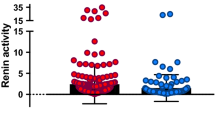Background: Resistance to insulin and secondary hyperinsulinemia seem to be the putative link between morbid obesity (MO) and hypertensive disease (HD). Adipose tissue can secrete leptin and angiotensinogen, among other substances. Leptin activates the sympathetic nervous system, leading to HD. Angiotensinogen is a substrate for renin, therefore taking part in the renin-angiotensin-aldosterone axis and the regulation of blood pressure. In MO, both hypertrophy and hyperplasia of the adipocytes lead to an increase in the secretion of both substances, leading to loss of the equilibrium between the levels of both hormones. The aim of the present study was to evaluate these abnormalities and their potential reversibility following bariatric surgery. Methods: Data from 100 patients with MO was retrospectively evaluated. Anthropometric data, the plasma renin activity (PRA), plasma levels of aldosterone, ACE, potassium and sodium were collected both prior to surgery and 6, 12, 24 and 36 months after surgery. Results: The waist-hip ratio (WHR) before surgery allowed classification of our patients in two groups: central obesity (WHR ≥0.90 in men and ≥0.85 in women); peripheral obesity (WHR <0.90 in men and <0.85 in women). In patients with central obesity, high levels of PRA, aldosterone and ACE with sodium retention and potassium loss and high insulin levels, were found. These changes were not found in patients with peripheral obesity. After gastric bypass, these abnormalities tended to disappear, mainly in the first 6 months. Conclusions: The reduction of BMI and WHR after gastric bypass confirmed this operation to be effective against MO. The high basal levels of insulin and the high rate of HD and diabetes in patients with central obesity seem to indicate that they suffer a metabolic syndrome with significant hormonal imbalances and sodium retention. Patients with peripheral obesity only showed a peripheral resistance against insulin, probably with a shorter duration of the hormonal action, but they did not show hormonal abnormalities or sodium retention. After gastric bypass these abnormal hormone levels tended to normalize.
Similar content being viewed by others
Author information
Authors and Affiliations
Rights and permissions
About this article
Cite this article
Ruano, M., Silvestre, V., Castro, R. et al. Morbid Obesity, Hypertensive Disease and the Renin-Angiotensin-Aldosterone Axis. OBES SURG 15, 670–676 (2005). https://doi.org/10.1381/0960892053923734
Published:
Issue Date:
DOI: https://doi.org/10.1381/0960892053923734




